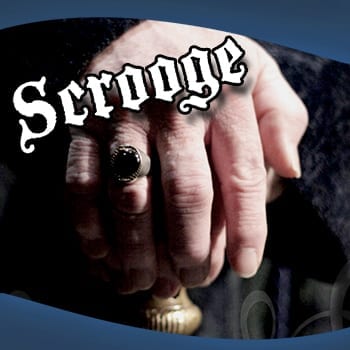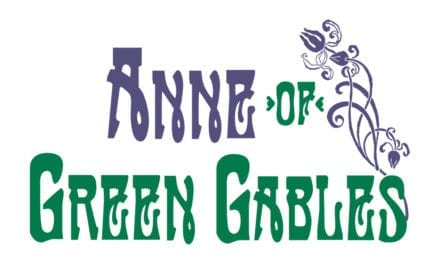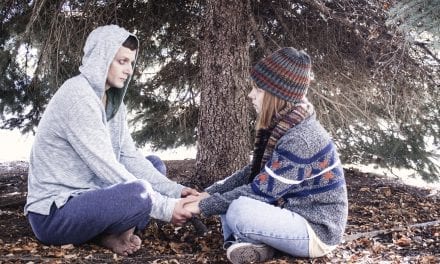CENTERVILLE — Charles Dickens‘s Christmastime tale of redemption, A Christmas Carol, was first published in 1843 and has since provided a basis for countless retelling in live action and animated cinema and on the theatrical stage. The story’s ubiquity has created an iconic set of characters including Tiny Tim and Bob Cratchit, the Ghosts of Past, Present, and Future, and and the stingy, old miser himself, Mr. Ebenezer Scrooge. This holiday season, Centerpoint Legacy Theatre has produced Leslie Bricusse‘s version of this classic tale, Scrooge.
After an evening of cold focus on business and finances, Mr. Scrooge returns home only to be visited by his old deceased business partner, Jacob Marley, who has come with a warning that old Scrooge must make a major transformation in order to escape the chains forged by his deeds. Scrooge responds with his trademarked, “Humbug,” as he is told to expect three ghosts throughout the night and retires with disbelief.
There can be many challenges associated with telling a familiar story, the greatest of which is presenting characters who exceed the audience’s preconceived expectations. While director Addie Holman cast delightfully talented actors and actresses and created a believable and heartfelt story, there were moments where I felt the characters were not real people. The Cratchit family seemed a playful and loving group; however, I could not accept them as a family. At times Bob Cratchit (Scott Taylor) looked as old as Scrooge, making it difficult to believe him as the father of a young boy. In addition, Tiny Tim’s four siblings were each of a similar age and size. When the family stood side by side at the end of “The Beautiful Day,” it looked as though Mr. and Mrs. Cratchit were the parents of quadruplets followed by a younger son. Although Truman Harris gave Tiny Tim a beautiful voice, I found him to be unconvincing as a cripple. Had the script and my prior knowledge of the plot not informed me that Tiny Tim’s health was waning, I would never have known it.
Another distraction was the overall inconsistency among actor’s accents. The most significant example was the different degrees of accents employed by the three actors cast to play Ebenezer at various ages. Parker Boss used a stronger accent as Young Ebby than did Tyler Wall as Young Ebenezer. As the elder Scrooge, Scott VanDyke‘s accent fell somewhere in the middle, although it was stronger during his spoken lines and more subtle when he sang. This phenomenon of a disappearing accent was fairly widespread through much of the cast. In general, it was the youngest actors, including Boss and Muller, who presented the most consistent accents.
Despite these areas of disconnect, I enjoyed several impressive moments in this production. Treion Muller and Marsha Holmes as Mr. and Mrs. Fezziwig provided the biggest surprise of the evening and brought a refreshing energy to an otherwise heavy production. I appreciated the playful tone as they welcomed friends and family to the Christmas celebration. VanDyke’s portrayal of Scrooge was convincing and enjoyable. I liked his matter-of-fact approach to the character, steering more toward a brusque businesslike manner than an angry persona, such as in his first office scene as he busily blotted out an ink spill between delivering his lines. His most vulnerable moment came during the song “Better Life” as Scrooge awaited the transition from present to future. In this scene, it became apparent that Scrooge did not need to change as a person; his desire to establish more balanced priorities would help him make the changes he desired.
Another standout in this production was Maggy Lawrence‘s choreography. There were so many great production numbers including the clever chain sequence in “Make the Most of This Life,” the social dance patterns in “December the 25th,” and the precision and detail of “Thank You Very Much.” Lawrence designed movement that helped translate Bricusse’s occasionally conflicting musical settings into the emotions necessary for each song. While the tonality of songs like “Christmas Children” and “Father Christmas” tended to portray an emotion in direct contrast to the lyrics, Lawrence provided choreography that helped each character and ensemble member advance the story. In addition, the choreography in each number was impressively clean and concise. My favorite moment was a ripple sequence in “Thank You Very Much” which was later repeated in the reprise. Despite each line executing different movements, the detail in the movement was still apparent.
As music director Megan Cash helped develop the many beautiful solos and small group numbers throughout the show. My favorite solo voices included Tyler Wall as Fred and Chantelle Bender as the Ghost of Christmas Past. The ensemble singing, however, was harder to fully enjoy. First, the balance between the orchestration and the ensemble seemed tipped too far in the direction of the accompaniment. Secondly, I had difficulty understanding the diction of the ensemble, particularly in more wordy numbers like “The Minister’s Cat.” I occasionally felt as though I might be missing important bits of information as I struggled to catch the lyrics. Additionally, the ends of many of the ensemble songs failed to synchronize harmonically because of the many thick, contrasting vibratos. This was most apparent at the end of the first number, “Sing a Song of Gladness and Cheer.” The problem continued throughout “Christmas Children,” compounded by an unbalanced mix of harmony parts in the microphones.
It was the work of costumer Tammis Boam that truly set this production apart. The attention to detail in each of the ghost’s costumes added to their otherworldly presence. The Ghost of Chrismast Past wore a pale green dress and carried an intricate staff. Although I found the LED lights a bit off-putting, her silvery makeup and ornate headpiece added to her stunning presence. As the Ghost of Christmas Present, Carson Boss wore an open robe that revealed a cream nightshirt underneath. His willingness to dance around in his pajamas echoed the character’s “I Like Life” mantra. Though not a part of his costume, Boss’s chariot/slide combination certainly helped create a dynamic entrance. As the last ghost, Parker Hedin hung suspended clad in a black, feathered cloak, an effect heightened by red lighting designed by B. Ivan Moss. Considering this character doesn’t even speak, the effect of both costuming and lighting was essential in establishing his presence. In addition to these great character pieces, I appreciated the historical accuracy applied in the ensemble costumes. “December the 25th,” a song set in Scrooge’s past, featured Regency era empire-waist dresses while the scenes set in the present day matched popular Victorian styles. The difference between economical classes was readily apparent, especially in each character’s outerwear.
As Scrooge made amends at the end of his journey and the overall emotion on stage changed on a dime, I reflected on my own personal lack of emotional connection to Scrooge’s change of heart. While this Centerpoint Legacy Theatre production of Scrooge certainly told the familiar story, there were few moments in which I found myself rooting for the change of heart I already knew would come. Perhaps that is greatest challenge of telling such a well-known tale. It is difficult to create suspense when the audience already knows the end of the story. Dickens penned stories he hoped would incite change in the hearts and actions of the people. While Centerpoint has created a visually stunning retelling of Dickens’ classic story, I was sadly unable to connect emotionally with the already familiar material. However, for those less familiar with this Bricusse script and score, perhaps it is just the thing to bring about a Christmas-inspired change of heart.








